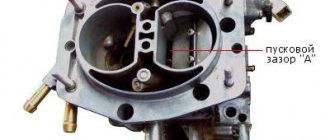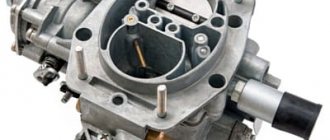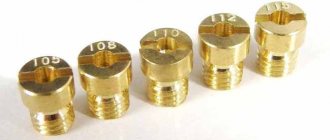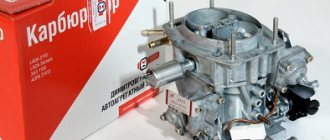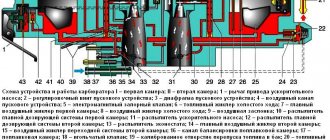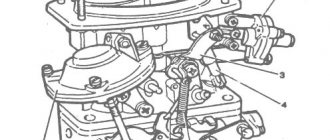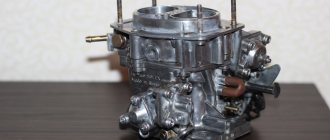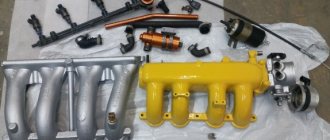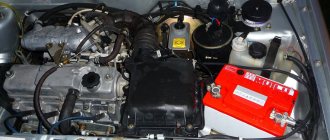Purpose of the economizer VAZ 2107
The full name of the economizer is forced idling economizer (EFS). From the name it is clear that its main function is to regulate the supply of fuel to the combustion chambers in idle mode.
The first VAZ 2107 models were equipped with economizers produced by DAAZ
The economizer allows you to save quite good fuel. This is especially true when driving on long descents, where the driver applies engine braking. At such moments, the EPHH does not allow fuel to enter the idle system. This, in turn, not only leads to a reduction in fuel consumption, but also increases traffic safety. The fact is that a car moving downhill in a low gear and constantly braking with the engine is much more stable on the road compared to a car freely rolling down the mountain at neutral speed.
Location of the economizer VAZ 2107
The VAZ 2107 economizer is located at the bottom of the carburetor next to the air filter.
Getting to the VAZ 2107 economizer, located at the bottom of the carburetor, is very difficult
Therefore, before dismantling the economizer, you will have to remove the air filter - there are no other ways to get to the EPHH.
Operating principle of the economizer
The VAZ 2107 economizer consists of:
- solenoid;
- shut-off actuator, made of plastic and performing the functions of a conventional needle valve;
- main idle jet.
If the accelerator pedal is not pressed and the crankshaft rotates at a speed below 2000 rpm, the EPHH is activated and shuts off the supply of the fuel mixture to the idle channel. The economizer is turned on when a signal is sent to it from the vehicle's control unit, connected to a microswitch in the ignition system.
The economizer receives only two types of signals from the control unit: opening and closing
When you press the gas pedal and the crankshaft rotation speed is above 2000 rpm, another signal is sent to the EPHH, turning it off, and the fuel supply to the idle channel is resumed.
Video: operation of the VAZ 2107 economizer
The operating procedure of the economizer of power modes of the Solex carburetor
When the car engine is running, chamber throttle 1 remains closed at idle. Therefore, an area of low air pressure appears under the damper. The economizer inlet is open, so the vacuum region extends to the diaphragm inside the economizer. The spring is gradually pulled back in the direction of the housing cover of the EPHH VAZ 2107. At this stage, the ball valve is closed.
After the driver presses the gas pedal, the pressure on the back side of the diaphragm drops, causing the valve to open. Then the fuel from the float chamber enters the emulsion well passing through the nozzle. At this moment, the fuel substance is well enriched with oxygen, so the car is given significant acceleration.
All 2021 Solex economizers come into operation only when the gas pedal is fully depressed.
Signs of malfunction of the VAZ 2107 economizer
There are several typical symptoms of a faulty VAZ 2107 economizer:
- The engine is unstable at idle speed. The diaphragm in the carburetor loses its tightness, and the economizer needle valve begins to partially shut off the fuel supply.
- The engine starts with difficulty, even if it has not yet cooled down.
- Fuel consumption increases by about a third, and sometimes doubles. The latter occurs if the EPHH needle valve becomes completely clogged, hangs in the open position and stops shutting off the fuel supply in a timely manner.
- An increase in fuel consumption is accompanied by a strong decrease in engine power.
- Traces of gasoline splashes appear near the power mode economizer.
The appearance of one or more of these symptoms indicates a high probability of a malfunction of the economizer and the need to replace it.
Diagnostics and repair of EPHH
Diagnosing a faulty economizer is not that difficult; you just need to understand how it works and the principle of operation of the economizer. In the future, you will be able to eliminate the main difficulties yourself.
You can replace the EPHH or clean the jet without dismantling the carburetor. The procedure is carried out as follows:
- Carefully remove the air filter.
- Disconnect the power wire from the economizer, after which it should be unscrewed from the housing.
- Remove the jet and thoroughly wash it in kerosene.
- Briefly connect the economizer to the battery. If the drive is more than 5 mm, this indicates normal operation of the device. Otherwise, it will have to be replaced with a new one.
Important!
All repair and diagnostic work must be carried out with a dry carburetor, that is, the fuel must be drained from it.
To independently diagnose a malfunction of the EMR injection VAZ 2107, we suggest you watch the video:
VAZ 2107 economizer sensor and its purpose
Car owners usually call an economizer sensor an econometer. Econometers of type 18.3806 were installed on the first carburetor VAZ 2107. These devices allowed the driver to estimate the approximate fuel consumption in different engine operating modes - at low speeds, at high speeds and at idle.
The first carburetor VAZ 2107 models were equipped with econometers of type 18.3806
Economizer sensor location
The economizer sensor is located on the instrument panel above the steering column next to the speedometer. To dismantle it, simply remove the plastic panel covering the sensor.
The sensor is located in the upper left corner of the VAZ 2107 dashboard
Operating principle of the economizer sensor
The economizer sensor is a mechanical measuring device. It is a simple vacuum gauge that monitors the vacuum level inside the engine inlet pipe, since gasoline consumption is associated with this pipe.
The economizer sensor is a conventional mechanical vacuum gauge
The sensor scale is divided into three sectors:
- Red sector. The carburetor flaps are fully open. Fuel consumption is maximum (up to 14 liters per 100 km).
- Yellow sector. The carburetor flaps are approximately half open. Fuel consumption is average (9–10 liters per 100 km).
- Green sector. The carburetor flaps are almost completely closed. Fuel consumption is minimal (6–8 liters per 100 km).
The principle of operation of the sensor is quite simple. If the valves in the carburetor are almost closed, the vacuum in the intake pipe increases, gasoline consumption decreases, and the gauge needle goes into the green zone. If the engine operates at high speeds, the dampers open completely, the vacuum in the pipe reaches a minimum, gasoline consumption increases, and the gauge needle is in the red sector.
Carburetor adjustment
Adjusting the carburetor involves several steps:
- Adjust the position of the float as described above.
- Check and set the “quality” and “quantity” screws to the initial state. Screw them all the way and unscrew them 2-3 turns for the “quality” screw and 3-4 for the “quantity” screw.
- Connect a tachometer or auto tester to the “K” terminal of the ignition coil, and the second probe to the housing.
- Start and warm up the engine to a temperature of 90°C
- Use the “quality” screw to set the maximum idle speed. The gasoline supply increases when the screw is rotated counterclockwise.
- Use the “quantity” screw to set the speed higher, approximately 80-90 rpm.
- Using the quality screw, we determine whether these speeds are maximum; if not, then we repeat the procedure.
- If the position of the quantity screw does not affect engine speed, tighten the quality screw so that the speed drops by 800-900 rpm.
This carburetor adjustment may not be entirely accurate, but does not require special equipment.
Signs of a malfunction of the VAZ 2107 economizer sensor
Failure of the economizer sensor can be determined by two signs:
- the sensor needle went into the red zone and stopped moving;
- the sensor arrow reached the center of the yellow zone, stopped and began to twitch, not responding to changes in the crankshaft rotation speed.
This behavior of the needle is due to the fact that the teeth on the sensor tube are completely worn out or broken. The sensor needs to be replaced. It cannot be repaired, since there are no spare parts for it on the market.
Replacing the economizer sensor of a VAZ 2107
To replace the economizer sensor you will need:
- new sensor type 18.3806;
- flat blade screwdriver.
How to replace the economizer sensor
The panel that covers the sensor is quite fragile. Therefore, when dismantling it, you should not make much effort. The sensor is replaced according to the following algorithm:
- The panel above the economizer sensor is held on by four plastic latches. The tip of the screwdriver is carefully inserted into the slot above the sensor. Using a screwdriver as a lever, the panel is carefully pulled out until there is a quiet click, indicating that the latch has disengaged.
- Other latches are unfastened in a similar way. Access to the sensor is provided.
When removing the economizer sensor panel, be careful not to damage the plastic latches. - The sensor is attached with one bolt, which is unscrewed with a flat-head screwdriver. The sensor is removed, and the wires going to it are disconnected manually.
To remove the sensor, you need to unscrew one mounting bolt and disconnect the wires - The sensor is replaced with a new one. Reassembling the dashboard is done in the reverse order.
Thus, even an inexperienced car enthusiast can replace the forced idle economizer of a VAZ 2107. To do this, you just need to carefully follow the recommendations of specialists.
Video - Installation of the EPHH system
An increase in fuel consumption can be due to many factors, including improper operation of the EMR. If the valve spring is weakened or broken, the economizer valve will be constantly open, re-enriching the air-fuel mixture. When the gas pedal is fully pressed, this increases engine power, but in other modes, on the contrary, it leads to a drop in power. Because of this, the driver is forced to press harder on the gas, which further increases fuel consumption. If the EMR diaphragm has lost its seal or the cap is not tightened properly, gasoline will enter the intake manifold below the throttle valve and also leak out. The latter is especially dangerous because it can cause fuel to ignite.
